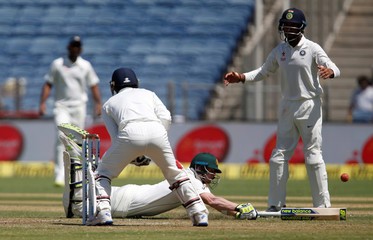
I had stopped watching cricket on television or tracking the game many years back. I don’t remember exactly when I lost interest though. In any case, I was not a fan by any Indian standards. Yes, we played some cricket during school days, near home with cousins, with sturdy bats made of coconut stem, which also sometimes served as unwieldy hockey sticks.
Sometime in the late 80s, I did watch some cricket in an old TV, which being black & white, could not bleed blue at all, while biting nails and jackfruit chips alternatively. Often during the match, I had to carefully climb the tiled roof and turn the antenna in different directions, while my sisters reported from ground how Manoj Prabhakar’s face was swinging off side or on side, depending on antenna’s direction. Those days, antennas were often owner’s envy and neighbor’s pride, especially when the neighbor didn’t have a television. No antenna worth its aluminium could stand up against the winds that swept the Palghat plains. If Ravi Shastri was batting and if I spent even an hour or more on the roof, nothing much would have changed on the score board. If I remember correctly, I did watch a lot of matches during 1986–88. Apart from the matches, the Bodyline serial on DoorDarshan also held my breath, while it played out on the screen. And post-match mornings were served delightfully by R. Mohan’s reporting in The Hindu.
Over the years, my loss of interest started at the same time as too much of analysis and discussions started around cricket on television. Analysis in talk shows that goes like this “Yes, I think this is going to be an interesting game, the pitch is going to be a little hard, a slow outfield… I think If India needs to win, the boys will have to bat well, bowl well, and field well!” Oh yes, what a revelation! Thank you! (insert a facepalm emoji here). Only umpiring was spared. The armchair analysis started during breaks, post-match, pre-match, and may be later even to standalone shows. Analysis with so many charts with data on speed, angle, and many other such things, which I don’t even understand, was filling the screens. And with IPL came many more new things strategically, including the strategy break. And too many advertisements. Though I can’t complain since advertisement industry paid all of my EMIs, grocery bills, the fine for not getting PUC check done for my car… well, all that is payable by me was paid by my advertising job. So, the comment on advertisements stands rolled back.
All this I remembered when I heard about the conversations surrounding Manjrekar and Jadeja. I happened to watch part of the India-NZ semifinal, the first ever game I watched this year, and got to know who all are playing for India (yes, sorry). I hadn’t heard about Manjrekar’s earlier criticism of Jadeja. Till Twitter started doing its job.
Everyone in India considers himself/herself as an absolute expert in cricket and has a strong opinion, which he/she believes is the absolute truth. That is an old news. Combine that with our new obsession of data, analysis, expert opinion, often by rehabilitated stars. Getting lost in this verbal and data diarrhea, is the simple, serendipitous way of watching the game.
(the title is inspired by title of the book, ‘Love in the time of Cholera’ though I am not sure it is a justifiable inspiration)